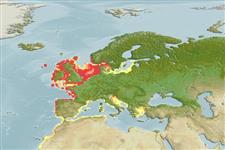Malacostraca |
Decapoda |
Portunidae
Environment: milieu / climate zone / Mức độ sâu / distribution range
Sinh thái học
; Mức độ sâu 0 - 80 m (Tài liệu tham khảo 356), usually ? - 40 m (Tài liệu tham khảo 435). Temperate; 4°C - 28°C (Tài liệu tham khảo 112013), preferred 9°C (Tài liệu tham khảo 107945); 61°N - 24°N, 16°W - 28°E
Atlantic and the Mediterranean Sea: From western Norway to the UK to Western Sahara and the Mediterranean coasts of Spain, France and Italy. Subtropical to temperate.
Length at first maturity / Bộ gần gũi / Weight / Age
Chín muồi sinh dục: Lm 4.8, range 4 - 5.95 cm Max length : 10.9 cm CL con đực/không giới tính; (Tài liệu tham khảo 96051); 9.84 cm CL (female); common length : 4.5 cm CL con đực/không giới tính; (Tài liệu tham khảo 435); Tuổi cực đại được báo cáo: 8 các năm (Tài liệu tham khảo 96051)
Maximum depth range from Ref. 101396. Maximum carapace width: 8.4; common carapace width: 5.5 cm (Ref. 435). Common in shallow waters from the intertidal to 80 m (Ref. 83653), common at depths not deeper than 40 m (Ref. 435). Found mostly in rocky shores, confined to the lower tidal mark (Refs. 101396). Inhabits on sand or mud (Ref. 435). Carnivore; trophic level 2.6 (Ref. 96418), trophic level 2.98 (Ref. 435). An opportunistic feeder, mostly preys on molluscs and crustaceans and also feeds on detrital material and large quantities of brown algae (Ref. 96482).
Members of the order Decapoda are mostly gonochoric. Mating behavior: Precopulatory courtship ritual is common (through olfactory and tactile cues); usually indirect sperm transfer.
SAUP Database 2006 SAUP Database. www.seaaroundus.org. (Tài liệu tham khảo 356)
IUCN Red List Status
(Tài liệu tham khảo 130435: Version 2025-1)
CITES status (Tài liệu tham khảo 108899)
Not Evaluated
CMS (Tài liệu tham khảo 116361)
Not Evaluated
Threat to humans
Human uses
Các nghề cá: Tính thương mại
FAO - Các nghề cá: landings | FishSource | Biển chung quanh ta
Các công cụ
Thêm thông tin
PhysiologyThành phần ô-xy
Human RelatedStamps, coins, misc.
Các nguồn internet
Estimates based on models
Fishing Vulnerability
Low to moderate vulnerability (33 of 100).
Climate Vulnerability
High vulnerability (56 of 100).
Nutrients : Calcium = 109 [35, 184] mg/100g; Iron = 1.59 [1.21, 1.97] mg/100g; Protein = 20.2 [19.2, 21.3] %; Omega3 = 0.285 [0.185, 0.386] g/100g; Selenium = 48.3 [-31.7, 128.3] μg/100g; VitaminA = 0 μg/100g; Zinc = 1.79 [1.17, 2.40] mg/100g (wet weight); based on
nutrient studies.
